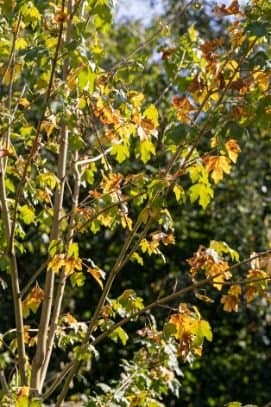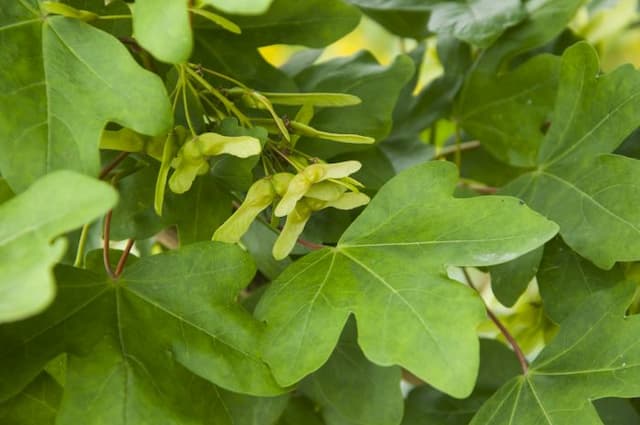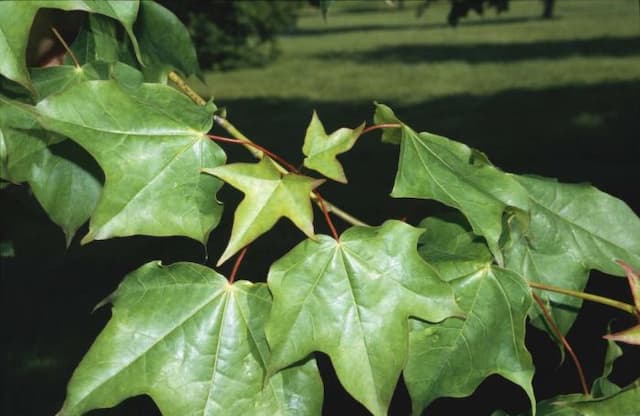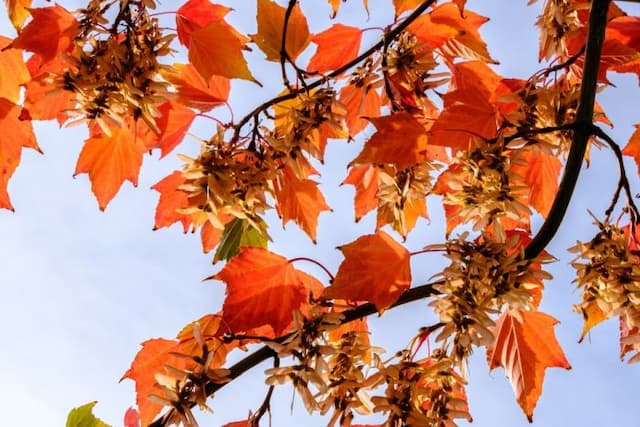Silver Cardinal Maple Acer 'Silver Cardinal' (v)

ABOUT
Acer 'Silver Cardinal', commonly known as a variety of maple tree, is admired for its striking foliage and attractive bark. This cultivar displays a unique palette of leaf colors throughout the seasons. In spring, the new leaves emerge with a stunning splash of pinkish-red and cream hues, which often have a noticeable silver sheen, justifying the 'Silver' part of its name. As the leaves mature, they transition to a variegated blend of green and white, which provides a cooling effect to the landscape during the hot summer months. The leaves of Silver Cardinal maple are characteristically palmate, resembling the shape of a hand with outspread fingers, that is a signature feature of maples. The edges of the leaves are finely serrated, bringing a delicate texture to the garden. In autumn, the foliage transforms yet again, often taking on hues of vivid red and oranges that are typical of maple trees, providing a final seasonal show before the leaves drop. Silver Cardinal maple's bark is an additional point of visual interest. Although it may not be as prominent as the foliage, the bark provides a subtle interplay of colors and textures. It tends to be smooth with a grayish undertone and can develop slight fissuring as the tree matures, adding to its ornamental charm. While the appearance of Acer 'Silver Cardinal' changes with the seasons, the overall impression this tree leaves is one of elegance and beauty, making it a cherished addition to gardens where a medium-sized colorful feature is desired.
About this plant
 Names
NamesSynonyms
Silver Cardinal Maple
Common names
Acer 'Silver Cardinal' (v)
 Toxicity
ToxicityTo humans
The Acer 'Silver Cardinal' is commonly known as a variety of Maple. Maples, in general, are not known to be toxic to humans. They do not typically contain compounds that are harmful when touched or ingested. Therefore, there are no common symptoms of poisoning from Maples for humans, as they are usually considered safe. However, it is always prudent to exercise caution with plants and avoid ingesting plant material that is not meant for consumption, as individual reactions can vary.
To pets
The Acer 'Silver Cardinal,' commonly referred to as a Maple, is not highly toxic to pets. However, some types of Maples can be harmful if ingested in large quantities. For example, the Red Maple (Acer rubrum) leaves can be toxic to horses if ingested in large amounts, leading to symptoms like anemia and dark brown or red urine. Dogs and cats are typically not affected in the same way, but it is still recommended to prevent pets from ingesting plant material. If a pet ingests a large amount of Maple leaves or any other part of the plant and shows signs of distress, contact a veterinarian.
 Characteristics
CharacteristicsLife cycle
Perennials
Foliage type
Deciduous
Color of leaves
Variegated
Height
15 feet 4.5 meters
Spread
10 feet 3 meters
Plant type
Tree
Hardiness zones
5
Native area
Asia
Benefits
 General Benefits
General Benefits- Ornamental Value: The Acer 'Silver Cardinal', commonly known as maple, has attractively variegated foliage with pink, white, and green colors that provide visual interest in gardens.
- Seasonal Interest: Maples have a seasonal appeal with spring blossoms, vibrant summer foliage, and stunning autumn colors that enhance the garden's appearance throughout the year.
- Shade Provision: As a medium-sized tree, it can provide ample shade during hotter months, creating a comfortable outdoor space.
- Wildlife Habitat: Maple trees can serve as habitats and food sources for wildlife such as birds and small mammals, supporting biodiversity.
- Soil Erosion Control: The root system of maples can help stabilize the soil, reducing erosion and improving soil health.
- Low Maintenance: Once established, maples usually require minimal upkeep, aside from occasional pruning and watering, making them suitable for low-maintenance landscapes.
- Climatic Tolerance: Maple trees can adapt to a range of climatic conditions, making them versatile additions to many gardens across different regions.
 Medical Properties
Medical PropertiesThis plant is not used for medical purposes.
 Air-purifying Qualities
Air-purifying QualitiesThis plant is not specifically known for air purifying qualities.
 Other Uses
Other Uses- Acer 'Silver Cardinal' wood can be used for fine woodworking projects, including musical instruments and small decorative items, due to its fine grain and workability.
- The samaras, or winged seeds, of the Acer 'Silver Cardinal,' can be used in educational settings to demonstrate principles of aerodynamics and wind dispersal in plants.
- This plant can serve as a natural dye source; leaves can provide a range of colors from yellow to brown when used in traditional fabric dying techniques.
- The branches of the Acer 'Silver Cardinal' can be used in floral arrangements, adding unique texture and color with their bright red and green hues.
- Young stems can be harvested for basket weaving, offering a distinctive red color to handcrafted products.
- Acer 'Silver Cardinal' leaves can act as artistic inspiration or direct components in eco-printing, a method where leaves are pressed onto fabric, leaving their imprint.
- The bark, which peels as the tree ages, can be used in crafting for its textured appearance in projects like creating naturalistic scenes or model making.
- During the fall, when Acer 'Silver Cardinal' leaves change color, they can be collected and used for creating seasonal decorations, such as wreaths and table centerpieces.
- Educationally, this tree can be planted in schools and used to teach students about seasonal changes, photosynthesis, and tree growth patterns.
- Gardeners may use pruned branches and foliage as a natural mulch to acidify the soil and retain moisture around acid-loving plants.
Interesting Facts
 Feng Shui
Feng ShuiThe Maple tree is not used in Feng Shui practice.
 Zodiac Sign Compitability
Zodiac Sign CompitabilityThe Maple tree is not used in astrology practice.
 Plant Symbolism
Plant Symbolism- Strength and Endurance: As a variety of maple (Acer), 'Silver Cardinal' maple symbolizes strength and endurance due to the hardwood nature of maple trees, which are often known for their ability to withstand harsh conditions and grow in various climates.
- Wisdom: Maples are commonly associated with wisdom, reflecting the tree's long lifespan and the ability to thrive over time, mirroring the accumulation of knowledge through the ages.
- Balance: The 'Silver Cardinal' maple, with its distinctive foliage that often presents a balanced mixture of colors, may represent balance and harmony in one's life, reflecting the equilibrium found in nature.
- Independence: Maples are known to grow well independently, symbolizing self-sufficiency and personal growth. This trait may inspire individuals to embrace their journey towards independence.
 Water
WaterThe Silver Cardinal Maple should be watered deeply once a week, providing the soil with approximately 1 to 1.5 gallons of water during the growing season. During hot and dry periods, increase the frequency to twice a week, ensuring the soil remains consistently moist, but not waterlogged. Reduce watering to every other week as the weather cools in fall, and during dormancy in winter, only water if the soil is very dry. Always check the soil moisture at a depth of around 4 inches and water if it feels dry at that level.
 Light
LightThe Silver Cardinal Maple prefers partial shade to full sun. It thrives in a location where it can receive morning sunlight and be protected from the intense heat of the afternoon sun. Avoid placing it in deep shade, as this can reduce the vibrancy of its foliage.
 Temperature
TemperatureThe ideal temperature range for the Silver Cardinal Maple is between 60°F to 80°F. It can tolerate a minimum temperature down to around -10°F and a maximum temperature up to approximately 90°F. Avoid exposing the plant to extreme temperatures and provide mulch to protect its roots in both hot and cold weather.
 Pruning
PruningPruning the Silver Cardinal Maple is important to maintain its shape and remove any dead or damaged limbs. The best time to prune is late winter or early spring before new growth starts. Prune sparingly, focusing on crossing branches or any growth that detracts from the tree's natural form. Annual thinning may be beneficial to promote air circulation and light penetration.
 Cleaning
CleaningAs needed
 Soil
SoilThe 'Silver Cardinal' Maple, a variant of Acer, thrives in well-draining, loamy soil that is rich in organic content. The ideal soil mixture for this maple should have a balanced mix of garden soil, peat, and perlite or coarse sand to enhance drainage. The pH level of the soil should be slightly acidic to neutral, ranging between 5.5 to 7.5 to facilitate optimal nutrient uptake and growth.
 Repotting
RepottingThe 'Silver Cardinal' Maple generally does not need frequent repotting. Young maples might require repotting every 2-3 years to accommodate root growth. As it matures, repotting frequency can decrease, necessitating repotting only every 4-5 years or when the roots significantly outgrow the pot.
 Humidity & Misting
Humidity & Misting'Silver Cardinal' Maple benefits from moderate ambient humidity levels; ideal humidity for this plant ranges from 40% to 60%. Consistent levels within this range promote healthy leaf growth and reduce the risk of stress.
 Suitable locations
Suitable locationsIndoor
Place in a bright, indirect light setting with some direct morning sun.
Outdoor
Plant in well-draining soil, partial sun to light shade exposure.
Hardiness zone
5-8 USDA
 Life cycle
Life cycleThe 'Silver Cardinal' Maple begins its life as a seed, usually requiring stratification to stimulate germination. Upon sprouting, it enters the seedling stage, where it puts down roots and grows its first leaves. As a juvenile, it focuses energy on rapid growth and begins to establish a robust vascular system and woody stem structure. Reaching maturity after several years, it develops a fuller canopy and starts the reproductive process, producing flowers that, after pollination, yield samaras or "helicopter seeds." These seeds disperse, often carried by wind due to their unique shape, to colonize new areas. As an older adult, the tree continues to produce seeds annually and may undergo periods of dormancy during colder seasons, until it reaches the end of its life cycle due to age, environmental stresses, or disease.
 Propogation
PropogationPropogation time
Spring-Early Summer
Propogation: Acer 'Silver Cardinal', commonly known as the Silver Cardinal Maple, is often propagated by softwood cuttings taken in late spring or early summer when the new growth is still flexible and not fully matured. The most popular method involves cutting a section of the stem about 4 to 6 inches (10 to 15 centimeters) long, with at least two sets of leaves. This cutting should be taken from a healthy parent plant. The lower leaves are removed and the cut end dipped in rooting hormone to encourage root development. The cutting is then placed in a pot filled with a mixture of peat and perlite, ensuring good drainage while retaining sufficient moisture. The pot is then covered with a plastic bag or placed in a propagator to maintain high humidity around the cutting. It is kept in a warm place with indirect sunlight until roots have formed, which usually takes several weeks, after which it can be transplanted to a more permanent location.









